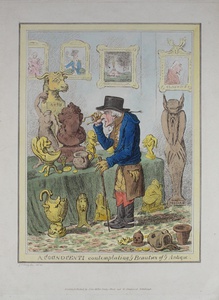| Method | Etching with hand original colouring |
| Artist | after James Gillray |
| Published | London. Published by John Miller, Bridge Street & W. Blackwood, Edinburgh. c. 1824 |
| Dimensions | Image 214 x 159 mm, Sheet 321 x 224 mm |
| Notes |
A reduced copy of Gillray's famous satire of William Hamilton, British envoy to the Kingdom of Naples. Gillray's caricature was originally published on the 11th of February 1801, probably in response to the return of Hamilton and his wife Emma in October of the previous year after the recapture of Naples by the French. Hamilton is depicted as an old man, stooped, frail, and small. He wears a low crowned top hat and spencer coat, gloves (one of which he has removed), and spurred riding boots. In one hand he holds a cane, and with the other he looks through a pair of spectacles at his collection of antiquities. The antiquities are a strange assortment of grotesques, broken vases, and objects suggestive of his misplaced interests. On the table before him is a fragmentary bust modelled on his wife Emma, labelled 'Lais' after the famous courtesan of Corinth. Beside the bust is a headless nude statue of a bacchant, making reference to the famous Attitudes his wife would model for artists such as George Romney, who visited her at her husbands villa on the Bay of Naples. On the other side of the bust, a corpulent cupid cries over his flaccid arrow. Against the wall, a sarcophagus-like object is inscribed 'Midas' and features the prominent donkey-ears of this foolish mythic king of Phrygia. Rounding out the lampoon are a set of four framed paintings on the wall above Hamilton's head. On the left, a bare-breasted portrait of Emma clutching a bottle of gin acts as the 'Cleopatra' to Nelson's 'Mark Antony.' Beside them is a landscape of an erupting volcano, ostensibly referring to Hamilton's work on Vulcanology for the Royal Society, but also acting as a barely veiled reference to his wife's inflamed passions. In the right corner, an elderly and forlorn Claudius, clearly representing the oblivious Hamilton, turns his back on the lovers and their volcano. Sir William Hamilton (1730-1803) was a British diplomat, antiquarian, connoisseur, and pioneering vulcanologist, who served as British Ambassador to the Kingdom of Naples between 1764 and 1800. While in Naples, Hamilton amassed two large and impressive collections of classical vases, the majority of which came from the excavations of Pompeii, Herculaneum, and the other ancient towns surrounding Mount Vesuvius. In addition to his antiquarian interests, Hamilton was also elected to the Royal Society for his studies of volcanic activity in Sicily and the Campi Phlegraei. Despite frequently being lampooned as a cognoscento by contemporary satirists like Gillray, Hamilton did not consider himself to be an antiquarian, even going so far as to lampoon the latter himself, by teaching his pet monkey to carry a magnifying glass in the manner of a connoisseur. Despite his achievements in archaeology, art history, and natural history, Hamilton is best known as a cuckold, his second-wife, Lady Emma Hamilton, having embarked on an infamous affair with Lord Nelson. James Gillray (c.1756-1815), was a British caricaturist and printmaker famous for his etched political and social satires. Born in Chelsea, Gillray studied letter-engraving, and was later admitted to the Royal Academy where he was influenced by the work of Hogarth. His caricature L'Assemblée Nationale (1804) gained huge notoriety when the Prince of Wales paid a large sum of money to have it suppressed and its plate destroyed. Gillray lived with his publisher and print-seller Miss (often called Mrs) Humphrey during the entire period of his fame. Twopenny Whist, a depiction of four individuals playing cards, is widely believed to feature Miss Humphrey as an ageing lady with eyeglasses and a bonnet. One of Gillray's later prints, Very Slippy-Weather, shows Miss Humphrey's shop in St. James's Street in the background. In the shop window a number of Gillray's previously published prints, such as Tiddy-Doll the Great French Gingerbread Maker [...] a satire on Napoleon's king-making proclivities, are shown in the shop window. His last work Interior of a Barber's Shop in Assize Time, from a design by Bunbury, was published in 1811. While he was engaged on it he became mad, although he had occasional intervals of sanity. Gillray died on 1 June 1815, and was buried in St James's churchyard, Piccadilly. Copy of BM Satires 9753 Condition: Trimmed within plate to sides. Minor puncture hole to top centre. Good, clean impression, with very minor time toning. |
| Framing | unmounted |
| Price | £300.00 |
| Stock ID | 47755 |

